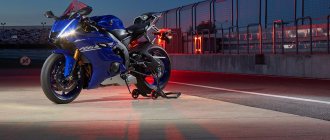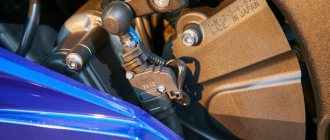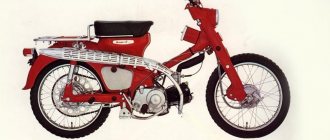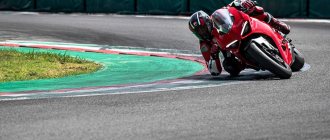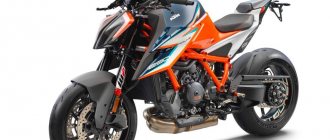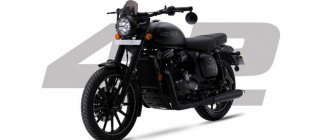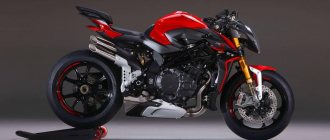| Yamaha R1 (1998-1999) | Yamaha R1 (2000-2001) | Yamaha R1 (2002-2003) |
| Yamaha R1 (2004-2005) | Yamaha R1 (2006) | Yamaha R1 (2007-2008) |
| Yamaha R1 (2009-2014) | Yamaha R1 (2015+) | Yamaha R1M (2015+) |
| Yamaha R1 World GP 60th Anniversary Edition |
Model of the flagship sports motorcycle Yamaha YZF-R1
was first presented on September 15, 1997 at the EICMA exhibition in Milan. This motorcycle became a successor to the Yamaha YZF1000R Thunderace (despite the fact that both models were produced in parallel for some time, the Thunderace began to be positioned on the market as a sports tourer), which received a new frame, a new generation of the Genesis engine, an inverted fork and improved characteristics for track - ergonomics, weight reduction, improved handling, increased engine power.
By 2000, the Yamaha R1 model underwent its first restyling. Despite the fact that there were practically no visual changes, the model was significantly different from the previous generation. The curb weight decreased by 4 kg, the exhaust system became titanium, aerodynamics improved (by 3%), the shape of the windshield changed (for better wind protection for the pilot), the fuel tank received more comfortable recesses for the legs, the seat and position of the footpegs changed (to shift the weight distribution forward ), the engine and transmission have changed: the camshafts received additional oil channels, the pusher clearances have decreased (all this led to a decrease in friction and engine noise), the gearbox has received a completely redesigned switching system (the problem with the gearbox inherent in early versions of the R1 has been resolved).
2002 was marked by the second update of the Yamaha YZF-R1, which consisted of replacing carburetors with an injector and significantly straightening the power take-off curve throughout the entire range of engine operation. The previous generation was distinguished by the fact that from 3000 rpm there was a sharp increase in torque, which in track racing or simply when using a motorcycle for civilian riding, leads to loss of control, falls and injuries to pilots. The engine received new liners, which reduced oil consumption. The new generation Deltabox frame, with minimal use of welds, has increased structural rigidity by 30%, while making the frame even lighter and more compact. The exhaust system has changed configuration from 4-into-1 to 4-2-1. The rear brake light has become LED. The front fork becomes thicker (41 → 43 mm).
In 2004, the model is updated again, receiving a new design with an under-seat exhaust system and radial front calipers (the diameter of the brake discs also increases: 298 → 320 mm). The new engine, with a higher compression ratio and shorter stroke, increases power to 172 hp. The inertial pressurization system (Ram-Air) is used for the first time. The injection system has double injectors. Already in the base the motorcycle is equipped with a steering damper. The frame geometry and weight distribution of the motorcycle have been changed to reduce the wheelie effect.
In 2006, the Yamaha R1 changed slightly, receiving engine optimization (+3 hp power) and a swingarm increased by 20 mm (to more stabilize the motorcycle during intense acceleration). The frame has changed. Motorcycles are equipped with a slipper clutch system.
In 2007, the model was significantly updated, receiving changes in appearance and technical parts. The model received an electronic throttle (YCC-T - Yamaha Chip Control Throttle) and an automatically variable intake manifold length (YCC-I - Yamaha Chip Control Intake). The engine compression ratio has increased, the 5-valve cylinder head has been replaced with a traditional 4-valve. Maximum power increases to 180 hp. The front braking system changes to 6-piston radial calipers and 310 mm diameter discs.
Since 2009, the Yamaha R1 model has undergone another serious restyling. The appearance of the motorcycle changes. The model receives a new engine with a cross-shaped crankshaft (Crossplane technology), on which the connecting rods are located at 90° angles relative to each other and the flares are spaced 270°-180°-90°-180°. This design gave the engine a special sound, similar to the sound of a V-shaped 4-cylinder engine and, according to Yamaha’s promises, gave the motorcycle virtually two engines in one, providing powerful traction from the bottom, like a V-shaped engine, and record power at the top, like in-line “fours”. In addition, the engine became even shorter stroke and increased power to 182 hp. The motorcycle also received the ability to choose from three engine operating modes - the D-Mode (Selectable Drive Mode) system. New rear shock absorber with more convenient adjustment. Minor changes to the frame. New magnesium subframe. New electronic steering damper. Since 2012, the model has been additionally equipped with traction control - the TCS (Traction Control System).
In 2015, Yamaha introduced a completely new model, the YZF-R1. New look. New magnesium wheels. New modification - Yamaha R1M
(features Öhlins electronic suspension, carbon fiber plastic, lightweight aluminum wheels, stainless steel exhaust, Communication Control Unit (CCU) and Y-TRAC racing systems - data logging system; Bridgestone racing tires and an increased rear wheel size - 200/55 ZR17 ). New engine with increased compression ratio and short stroke, maximum power - 200 hp. New frame. New braking system: disc diameter 320 mm, return to 4-piston radial calipers, brakes become combined (UBS - Unified Brake System) and receive an ABS system. The fuel tank becomes aluminum and reduces its capacity by 1 liter (18 → 17 liters). New electronic systems: SCS (Slide Control System), antiwheelie (LIF - Lift Control System), quickshifter (QSS - Quick Shift System), PWR Mode - Power Delivery Mode, replaced the previous D-Mode), launch control ( LCS - Launch Control System).
The 2020 Yamaha R1 and R1M received minor changes: a new Ride-by-Wire APSG (Accelerator Position Sensor with Grip) electronic throttle system, aerodynamic plastic changes, a new intake system (the manifold became smaller and shorter) with new Bosch injectors , a new BC (Brake Control) system, new brake pads (more efficient), new Bridgestone RS11 tires, slightly smaller optics, a new EBM (Engine Brake Management) system, the R1M version receives a new generation of Öhlins NPX forks.
Yamaha R1: electronic equipment
- Assist & Slipper clutch – 2006+
- YCC-T (Yamaha Chip Control Throttle) – 2007+
- YCC-I (Yamaha Chip Control Intake) – 2007+
- D-Mode (Selectable Drive Mode) - 2009+
- TCS (Traction Control System) - 2012+
- UBS (Unified Brake System) + ABS – 2015+
- SCS (Slide Control System) - 2015+
- LIF (Lift Control System) - 2015+
- QSS (Quick Shift System) up/down – 2015+
- PWR Mode (Power Delivery Mode) - 2015+
- LCS (Launch Control System) - 2015+
- BC (Brake Control) - 2020+
- Ride-by-Wire APSG (Accelerator Position Sensor with Grip) - 2020+
- EBM (Engine Brake Management) - 2020+
- Öhlins Electronic Racing Suspension (ERS) - R1M
- YRC (Yamaha Ride Control) - R1M
The main competitors of the Yamaha R1 (YZF-R1) in the class:
- Honda CBR1000RR
- Kawasaki ZX-10R
- Suzuki GSX-R1000
Brief history of the model
- 1998 - start of production and sales. First generation
.
Model
: Yamaha YZF-R1 (Europe, North America, Japan, Australia).
Factory designation
: 4XV5, 4XV4, 5EG1, 4XV2, 4XV1, 4XV6.
- 1999 - no significant changes.
Model
: Yamaha YZF-R1 (Europe, North America, Australia).
Factory designation
: 4XVB, 4XVA, 5EG2, 4XV8, 4XV7, 4XVC.
- 2000 - restyling of the model. Second generation
.
Model
: Yamaha YZF-R1 (Europe, North America, Australia).
Factory designation
: 5JJ5, 5JJ4, 5JJ2, 5JJ1, 5JJ7, 5JJ6.
- 2001 - no significant changes.
Model
: Yamaha YZF-R1 (Europe, North America, Australia).
Factory designation
: 5JJG, 5JJF, 5JJD, 5JJC, 5JJ9, 5JJ8, 5JJA, 5JJH, 5JJE.
- 2002 - restyling of the model. Third generation
.
Model
: Yamaha YZF-R1 (Europe, North America, Australia).
Factory designation
: 5PW5, 5PW4, 5PW2, 5PW1, 5PW6.
- 2003 - no significant changes.
Model
: Yamaha YZF-R1 (Europe, North America, South Africa, Australia).
Factory designation
: 5PWB, 5PWE, 5PWA, 5PWD, 5PW8, 5PW7, 5PWF, 5PWC.
- 2004 - restyling of the model. Fourth generation
.
Model
: Yamaha YZF-R1 (Europe, North America, South Africa, Australia).
Factory designation
: 5VY5, 5VY4, 5VY2, 5VY1, 5VY3, 5VY6.
- 2005 - no significant changes.
Model
: Yamaha YZF-R1 (Europe, North America, Japan, Australia).
Factory designation
: 5VYB, 5VYA, 5VY8, 5VY7, 5VYC, 5VYD.
- 2006 - restyling of the model. Fifth generation
.
Model
: Yamaha YZF-R1 + R1S (Europe, North America, Japan, Australia).
Factory designation
: 4B15, 4B14, 5VYM, 5VYL, 5VYJ, 5VYH, 5VYS, 5VYF, 5VYR, 5VYE, 4B12, 4B13, 4B11, 4B16, 5VYN, 5VYK, 5VYT.
- 2007 - restyling of the model. Sixth generation
.
Model
: Yamaha YZF-R1 (Europe, North America, Japan, Australia).
Factory designation
: 4C85, 4C84, 4C83, 4C82, 4C81, 4C86, 4C87.
- 2008 - no significant changes.
Model
: Yamaha YZF-R1 (Europe, North America, Japan, Australia).
Factory designation
: 4C8B, 4C8C, 4C89, 4C88, 4C8D, 4C8E.
- 2009 - restyling of the model. Seventh generation
.
Model
: Yamaha YZF-R1 (Europe, North America, Japan, Australia).
Factory designation
: 14B4, 14B5, 14B9, 14B6, 14B1, 14BA.
- 2010 - no significant changes.
Model
: Yamaha YZF-R1 (Europe, North America, Japan, Australia).
Factory designation
: 14BC, 14BM, 14BL, 14BF, 14BG, 14BN, 14BN, 14BJ.
- 2011 - no significant changes.
Model
: Yamaha YZF-R1 (Europe, North America, Japan, Australia).
Factory designation
: 14BR, 1KB5, 1KB1, 1KB6, 1KB2, 1KB7, 1KB3, 1KBA, 45B2.
- 2012 - the model receives the TCS (Traction Control System) traction control system.
Model
: Yamaha YZF-R1 (Europe, North America, Japan, Australia).
Factory designation
: 1KBJ, 1KB8, 1KBL, 1KBM, 1KBE, 1KBF, 1KBC, 1KBB, 1KBN, 1KBG, 1KBD, 1KBS, 45B4, 45B3.
- 2013 - no significant changes.
Model
: Yamaha YZF-R1 (Europe, North America, Japan, Australia).
Factory designation
: 45B5, 1KBT, 1KBW, 1KBX, 1KBY.
- 2014 - no significant changes.
Model
: Yamaha YZF-R1 (Europe, North America, Japan, Australia).
Factory designation
: 45B6, 2SG5, 2SG1, 2SG9, 2SG7, 2SG8.
- 2015 - restyling of the model. Eighth generation
.
The appearance of a new modification - Yamaha YZF-R1M
.
Model
: Yamaha YZF-R1 + R1M (Europe, North America, Japan, Australia).
Factory designation
: BH31, 2KS1, 2CR1, 2KS5, 2CR5, 2KS4, 2KS3, 2CR3, 2CR4.
- 2016 - no significant changes.
Model
: Yamaha YZF-R1 + R1M + R1S (Europe, North America, Japan, Australia).
Factory designation
: BH32, 2KSC, 2CRJ, 2CRC, B603, 2KSA, 2CRN, 2CRG, B601, B602, 2KS9, 2KS8, 2CRL, 2CRM, 2CRE, 2CRF.
- 2017 - no significant changes.
Model
: Yamaha YZF-R1 + R1M + R1S (Europe, North America, Japan, Australia).
Factory designation
: BX4A, 2KSF, BX41, 2KSJ, BX44, B604, B605, 2KSH, 2KSG, 8X42, 8X43.
- 2018 - no significant changes.
Model
: Yamaha YZF-R1 + R1M (Europe, North America, Japan, Australia).
Factory designation:
BX46 + 2KSM.
- 2019 - no significant changes.
Model
: Yamaha YZF-R1 + R1M (Europe, North America, Japan, Australia).
- 2020 - minor changes to R1 and R1M (a full list of changes is presented above in the review).
Model
: Yamaha YZF-R1 + R1M (Europe, North America, Japan, Australia).
- 2021 - no significant changes.
Model
: Yamaha YZF-R1 + R1M (Europe, North America, Japan, Australia).
- 2022 - the appearance of the anniversary version of the Yamaha YZF-R1 World GP 60th Anniversary Edition.
Model
: Yamaha YZF-R1 + R1M; Yamaha YZF-R1 World GP 60th Anniversary Edition (Europe, North America, Japan, Australia).
Chassis.
Yamaha's designers may not be very good at artistic crafts, but when it comes to creating a real motorcycle, they are second to none. The new Yamaha R1M is powered by the same liquid-cooled four-cylinder engine that produces 200 hp and 112.5 Nm. The engine is connected to a six-speed gearbox. The 2018 version of the bike now comes with a quick shifter (QSS) function for upshifts and an auto-blip function for downshifts. So now gears can be changed in any direction without using the clutch. And the best thing about all this is the ability to disable these functions. These power figures are impressive, especially when you realize that they were achieved without the use of air blowers. R1M is equipped with a unique technology - Communication Control Unit - CCU. Its job is to record trip data including lap time, speed, throttle position, track coordinates, bank angle, and uses GPS and Wi-Fi networks. Yamaha engineers injected the motorcycle with racing DNA by installing a crankshaft with crankpins located at an angle of 90° to each other, split connecting rods and forged pistons. The six-axis Inertial Sensor Unit and electronic throttle actuator are responsible for smooth throttle operation and linear power delivery right up to the red zone. Overall engine weight has been reduced with titanium connecting rods that are 60% lighter than steel, magnesium casings, ultra-lightweight aluminum mounts and a titanium exhaust system. Moreover, the latter centers the masses at the very bottom of the frame and clearly in the middle of the motorcycle. In addition, all of the above components give the engine a responsive and strong character, especially in the high rev range.
Specifications
Yamaha YZF-R1 Specifications:
| Model | Yamaha R1 (YZF-R1) |
| Motorcycle type | sport |
| Year of issue | 1998+ |
| Frame | aluminum Deltabox |
| engine's type | 4-cylinder, 4-stroke, in-line Crossplane (90° cranks) crankshaft – R1 (2009+) |
| Working volume | 998 cm³ |
| Bore/Stroke | 74.0 x 58.0 mm – R1 (1998-2003) 77.0 x 53.6 mm – R1 (2004-2008) 78.0 x 52.2 mm – R1 (2009-2014) 79.0 x 50.9 mm – R1 (2015+) |
| Compression ratio | 11.8:1 – R1 (1998-2003) 12.4:1 – R1 (2004-2006) 12.7:1 – R1 (2007-2014) 13.0:1 – R1 (2015+) |
| Cooling | liquid |
| Number of valves per cylinder | DOHC, 5 valves per cylinder – R1 (1998-2006) DOHC, 4 valves per cylinder – R1 (2007+) |
| Fuel supply system | Carburetor, 4x Mikuni BDSR40 – R1 (1998-2001) Injector, 4x Mikuni 40EIS – R1 (2002-2003) Injector, Mikuni 45EIDW – R1 (2004+) YCC-I (Yamaha Chip Control Intake) – R1 (2007+) YCC-T (Yamaha Chip Control Throttle) – R1 (2007+) |
| Ignition type | TCI |
| Maximum power | 150.0 hp (110.0 kW) at 10,000 rpm – R1 (1998-2001) 152.0 hp (112.0 kW) at 10500 rpm – R1 (2002-2003) 172.0 hp (126.0 kW) at 12500 rpm – R1 (2004-2005) 175.0 hp (129.0 kW) at 12500 rpm – R1 (2006) 180.0 hp (132.0 kW) at 12500 rpm – R1 (2007-2008) 182.0 hp (134.0 kW) at 12500 rpm – R1 (2009-2014) 200.0 hp (147.0 kW) at 13500 rpm – R1 (2015+) |
| Maximum torque | 108.0 Nm (11.0 kg*m) at 8500 rpm – R1 (1998-2001) 105.0 Nm (11.0 kg*m) at 8500 rpm – R1 (2002-2003) 107.0 Nm (11.0 kg*m) at 10500 rpm – R1 (2004-2006) 113.0 Nm (11.5 kg*m) at 10,000 rpm – R1 (2007-2008) 116.0 Nm (12.0 kg*m) at 10,000 rpm – R1 (2009-2014) 112.0 Nm (11.5 kg*m) at 11500 rpm – R1 (2015-2019) 113.3 Nm (11.6 kg*m) at 11500 rpm – R1 (2020+) |
| Clutch | Multi-disc in oil bath, cable drive |
| Transmission | 6-speed |
| type of drive | chain |
| Front tire size | 120/70ZR17 M/C (58W) |
| Rear tire size | 190/50 ZR17 (73W) – R1 (1998-2000) 190/55 ZR17 M/C (75W) – R1 (2009+) 200/55 ZR17 M/C (78W) – R1M |
| Front brakes | 2 discs, 298 mm, 4-piston calipers – R1 (1998-2003) 2 discs, 320 mm, 4-piston radial calipers – R1 (2004-2006) 2 discs, 310 mm, 6-piston radial calipers – R1 (2007-2014) 2 discs, 320 mm, 4-piston radial calipers (combined UBS - Unified Brake System + ABS) – R1 (2015+) |
| Rear brakes | 1 disc, 245 mm, 2-piston caliper – R1 (1998-2001) 1 disc, 220 mm, 2-piston caliper – R1 (2002-2003) 1 disc, 220 mm, 1-piston caliper – R1 (2004+) (2015+: combination UBS - Unified Brake System + ABS) |
| Front suspension | 41mm inverted telescopic fork (fully adjustable), 135mm travel – R1 (1998-2001) 43mm inverted telescopic fork (fully adjustable), 120mm travel – R1 (2002+) Öhlins electronic semi-active suspension – R1M |
| Rear suspension | Pendulum with monoshock absorber (fully adjustable), stroke - 130 mm - R1 (1998-2008) Pendulum with monoshock absorber (fully adjustable), stroke - 120 mm - R1 (2009+) Öhlins electronic semi-active suspension – R1M |
| Length | 2035 mm – R1 (1998-2001) 2040 mm – R1 (2002-2003) 2065 mm – R1 (2004-2005) 2085 mm – R1 (2006) 2060 mm – R1 (2007-2008) 2070 mm – R1 (2009-2014) 2055 mm – R1 (2015+) |
| Width | 695 mm – R1 (1998-2001) 705 mm – R1 (2002-2003) 720 mm – R1 (2004-2008) 715 mm – R1 (2009-2014) 690 mm – R1 (2015+) |
| Height | 1095 mm – R1 (1998-1999) 1105 mm – R1 (2000-2006) 1110 mm – R1 (2007-2008) 1130 mm – R1 (2009-2014) 1150 mm – R1 (2015+) |
| Wheelbase | 1395 mm – R1 (1998-2006) 1415 mm – R1 (2007-2014) 1405 mm – R1 (2015+) |
| Minimum ground clearance (clearance) | 140 mm – R1 (1998-2003) 135 mm – R1 (2004-2014) 130 mm – R1 (2015+) |
| Seat height | 815 mm – R1 (1998-2001) 820 mm – R1 (2002-2003) 835 mm – R1 (2004-2014) 855-860 mm – R1 (2015+) |
| Acceleration 0-100 km/h (0-60 mph) | 2.88 sec[1] |
| Maximum speed | 299 km/h - limiter |
| Gas tank capacity | 18.0 l (including reserve - 5.5 l) - R1 (1998-1999) 18.0 l (including reserve - 3.8 l) - R1 (2000-2001) 17.0 l (including reserve - 3.3 l) - R1 (2002-2003) 18.0 l (including reserve - 3.4 l) - R1 (2004-2006) 18.0 l (including reserve - 3.2 l) - R1 (2007-2008) 18.0 l (including reserve - 3.1 l) - R1 (2009-2014) 17.0 l (including reserve – 3.0 l) – R1 (2015+) |
| Motorcycle weight (curb) | 198 kg – R1 (1998-1999) 194 kg – R1 (2000-2001, 2006) 193 kg – R1 (2002-2005) 200 kg – R1 (2007-2008, 2015+) 206 kg – R1 (2009-2014) |
Yamaha YZF-R1 Video
We present to your attention a well-assembled selection of rides on this motorcycle, which well demonstrates all its capabilities. In the hands of a professional, a motorcycle can do incredible things. And the right music will make viewing even more enjoyable.
As one popular character in a Hollywood movie said, “You are either mad or a genius. These are two extremes of the same essence." The hero of the next video clip is just balancing on the brink. Perhaps it would even be possible to publish this video under the hashtag “Dementia and Courage”, if not for the professionalism of this motorcyclist.
In a word, see for yourself, decide for yourself. Carefully! It's breathtaking to watch.
Did you like the article? Tell your friends!
Comments (3)
- liz1990:
03/11/2015 at 03:36In fact, I have always respected this particular motorcycle manufacturer. In my opinion, this company is the most reliable. It produces truly high-quality and durable equipment.
Answer
- Dima:
05/24/2015 at 02:54
I also have enormous confidence in this company)) They really rarely break down. I started with the Joga 50cc, which broke down least often)) Now I ride on the indestructible YBR 125))
Answer
- Dmitriy:
08/15/2016 at 20:13
Ground clearance 136 cm - correct
Answer
Reviews
Reviews about Yamaha R1 (YZF-R1):
Expand Collapse
First trip from MREO…. I have never experienced such feelings. Northern Avenue, day, first gear before the cutoff 143 km/h, second, third 201 km/h. Immediately at the end of the northern avenue, across the road at the lowest speed, Qashqai begins to change lanes, slows down, catches its breath, and curses.))
The first weeks when I went into the garage I didn’t believe that it was mine, the motorcycle is very beautiful, it has an LED stop with turn signals inside, short crg levers, high pluig glass, xenon, 21-position biturbo damper, turn signals integrated into the fairing, the rear shovel has been removed.
Exploitation. I used r1 every day, to work and back, every night for rides, on the road the maximum speed is near the dam. The suspension is hard, the gas is sharp, the seating is uncomfortable, it’s hot in traffic jams, the consumption is...18 liters per 200 km. But you forget about this when you start it up and start driving, it repeats all your actions, just turning your head, just thinking about how you’re already tipping into a 90-degree turn, or driving 283 in Moscow. One of the serious disadvantages is that in traffic jams, if you get stuck very seriously, the frame and the seat heat up - one place boils. The brakes are above all praise, very tenacious! Acceleration - no joke, by the end of the day my hands and elbows hurt from the way he pulled!
Expenses. Oil about 3000 rub. Front pads original 3000 RUR x 2 non-original 1500 RUR x 2. Chain 6000 RUR. Stars front 1200 rear 3000r. Rear tires 10,000 rubles before 7,000 rubles. Xenon block (burnt out) 1000 RUR. I rode the motorcycle for 8000 km. There were no breakdowns. I bought it with 12,000 km mileage. The motorcycle is currently sold. I didn’t ride in the summer of 2012. Now I’m looking at Rku again, but now it’s 2007.
The new R1 has amazing acceleration, has 3 modes A, B, C, I ride in B, sometimes I turn on A. Mode A is a completely separate issue, the motorcycle is possessed by a demon. It’s not like he’s tearing up, he’s taking off in the literal sense of the word. The first 4 gears I was in reverse when I first turned on this amazing mode. And I got into the Erka after the CBR1000rr with 178 hp, and in the R1 182 hp. It seems like the difference is small, but the brains do their job. The bike steers perfectly, the brakes are excellent and very informative. There are also disadvantages in 1st gear: there are twitches (depending on the pilot), but they are there, I have tuned stars and somehow the ride is softer. By the way, I compared my Erka and my friend’s Erka, both motors are 2009, mine is European with tuned stars and a filter, and my friend’s is American. So the motorbikes travel differently (mine is better), although there is also an error in speed. There is one more small piece of garbage like the chain tensioner, when the engine starts there is a not very pleasant sound (it goes away in 2 seconds), you can change this tensioner every 10 thousand and there will be no sound.
You can see everything in the mirrors, the landing is basically comfortable, I drove 200 km in the normal 250 km per hour mode! The motorcycle is VERY worthy both from an aesthetic and practical point of view - beautiful, fast, comfortable......)
I bought it at the beginning of the summer of 2008 and sold it at the end of 2009.... I drove about 10 thousand, changed consumables and once the return spring in the box (the services announced at least 50 tr and repairs within 3 weeks) I disassembled the spring myself I bought it from a Lada in auto parts, since I had to wait a month for my original one and it wasn’t available for disassembly, the price of the spring, by the way, is 3 RUBLES, so before going to the service center, try to figure it out yourself-))) Otherwise there were no problems, consumption is about 12 liters in the city, I almost didn’t drive on the highway.... It certainly looks classy, I had a lot of tuning, xenon, etc., in short, everyone looked around -))) The maximum speedometer showed was 308 km/h, but I think I was going a little less.... The handling is excellent, the brakes too, the dynamics especially at high speeds are simply PLAGIC…. So whoever decides to buy it, take it, you won’t regret it, but choose a good option, go for diagnostics, save yourself time and money!!!... Now I’m thinking about what to take, I took a HONDA 600 SBR from a friend... a children’s device, in comparison with the Erka It’s just a laugh and the liter fuel tank isn’t very good either, although it’s very compact for urban conditions….in general, decide for yourself, but don’t say that the P1 is rubbish, breaks, etc., haven’t driven it yet.
Imported from Japan, bought after the cb400sf (which I crashed quite well), the result is that, although it is three times more powerful, it is much safer than its predecessor, it holds the road with a bang (with the exception of the rear brake, but if you work with your head, this is also not a minus)…..The dynamics are super, much better than those of the injection offspring, in principle, due to its small size, it resembles a turbocharged moped!) What was not very pleasing was the uncomfortable landing, it’s already difficult to travel 200 km, your back will hurt…About I can’t say anything about its durability in accidents, thank God I didn’t get into it, but it was lying on its side because of the absurdity the sliders would have worked if it weren’t for the TURN SIGNALS sticking out behind them, the plastic was a little damaged...ALS! ((What can we say about reliability, you can’t argue with that either, motz loves speed, but smooth acceleration, without jerking, if you drive wisely, there won’t be any expenses for it, change the current consumables and fly on the roads!)))) In general, I’m very pleased with the unit, but alas, I’m selling, my family needs a car!(
Motorcycle review. The bike is not for dummies.
This is a racing motorcycle designed for the track, for speed and only speed. With its sharp nose and light tail, the Erka resembles a space object, however, the bike can be identified even from afar and against the sun - Yamaha has remained true to itself. However, unlike the previous model: “hard”, brutal, the 2012 bike turned out to be more “sleek”.
The first thing that catches your eye is the seat. It is placed quite high, while other sportbikes have it lower. In reality, this gives additional opportunities to control one’s own body. Its tilt changes the trajectory and helps you take turns more accurately. True, this feature of the bike can play a cruel joke on a non-professional... But the Erka is not a machine for dummies...
Absolutely not for dummies! The bike reacts to the throttle not even like a dog that has finally been let off the chain, but like a projectile that was fired from a catapult - a hundred from first gear is normal. The maximum speed of the Yamaha R1 is 300 km/h!
It is clear that with such agility, the braking system must be very competent. “Special thanks to the designers” for it - on the track it works extremely effectively, providing safe braking at any speed: on a sharp turn after a straight section this is a big bonus for the racer.
In general, turns are the “strong point” of this bike, and the aluminum diagonal frame plays a significant role in this. It is light and, at the same time, tough. When cornering, when the suspension can no longer cope, it is the frame that takes the main load. This one does the job, while at the same time providing the bike with absolutely incredible handling.
Another pleasant point is the smooth gear shift without sudden jerks . At speeds that the motorcycle is capable of reaching - up to 300 km/h, this feature not only saves time, it can save lives. For comparison, the maximum speed of the Yamaha R6 is 265 km/h.
Of course, there is no question of any comfort here. The extremely stiff suspension will make you literally “feel” the track with your whole body. But the rider must feel the track!
Another very interesting motorcycle from the land of the rising sun: the Honda CBR600RR, the technical characteristics of which will appeal to many motorsport connoisseurs.
Do you want your children to engage in motorsports? We can help you decide on the choice of a children's gasoline motorcycle.
Results.
The 2021 R1 lineup takes a step closer to the M1's true racing pedigree. Motorcycles will delight drivers with improved suspension, gear shift patterns and fuel supply. Every effort has been made to ensure that they become
the most popular superbikes delivering maximum power both on and off the track.
The 2021 R1M gets as close to Yamaha MotoGP performance as possible thanks to carbon fiber body parts, a shorter wheelbase and fully adjustable Ohlins suspension. In the world of motorcycles, it's the Porsche 911. Everyone either wants to have one or "make" one on the track. Or maybe both. It's no surprise that the Japanese have chosen this particular monster to track since its release in the late 20th century.
